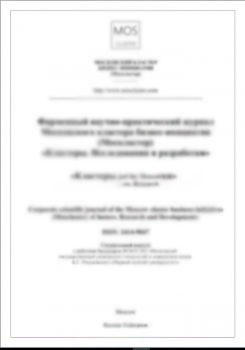Россия
Lomonosov Moscow State Universit
Россия
Россия
ГРНТИ 50.07 Теоретические основы вычислительной техники
ББК 3297 Вычислительная техника
This paper analyses the application of no-reference metric NIQE to the task of video-codec comparison. A number of issues in the metric behavior on videos was detected and described. The metric has outlying scores on black and solid-colored frames. The proposed averaging technique for metric quality scores helped to improve the results in some cases. Also, NIQE has low-quality scores for videos with detailed textures and higher scores for videos of lower bit rates due to the blurring of these textures after compression. Although NIQE showed natural results for many tested videos, it is not universal and currently can’t be used for video-codec comparisons.
video quality, no-reference metric, quality measuring, video-codec comparison
1. Cisco Report VNI 2017-2022,2018 update https://www.cisco.com/c/en/us/solutions/collateral/service-provider/visual-networkingindex-vni/white-paper-c11-741490.html
2. Crowd-sourced subjective quality evaluation platformsubjectify.us
3. HEVC Video Codec Comparison 2018(Thirteen MSU Video Codec Comparison)http://compression.ru/video/codec_ comparison/hevc_2018/
4. HEVC Video Codec Comparison 2018 (Thirteen MSU Video Codec Comparison), Part II:FullHD Content, Subjective Evaluation http://compression.ru/video/codec_ comparison/hevc_2018/#subjective_ reportMathWorks Documentation: Naturalness Image
5. Quality Evaluator (NIQE) no-reference imagequality score https://www.mathworks.com/help/images/ref/niqe.html
6. MSU Quality Measurement Tool: Download Pagehttp://compression.ru/video/quality_ measure/vqmt_download.html
7. C. Chen, S. Inguva, A. Rankin, and A. Kokaram, “Asubjective study for the design of multiresolution ABR video streams with the VP9codec,” in Electronic Imaging, 2016(2), pp. 1-5.
8. A. Mittal, R. Soundararajan, and A. C. Bovik,“Making a «completely blind» image quality analyzer,” in IEEE Signal Processing Letters, 2012,20(3) pp. 209-212.
9. A. Mittal, A. K. Moorthy, and A. C. Bovik, “Noreference image quality assessment in the spatialdomain,” in IEEE Transactions on Image Processing, 2012, 21(12), pp. 4695-4708.
10. A. K. Moorthy and A. C. Bovik, “Blind imagequality assessment: From natural scene statistics toperceptual quality,” in IEEE Transactions on ImageProcessing, 2011, 20(12), pp. 3350-3364.
11. M. Saad, A. C. Bovik, and C. Charrier, “Blindimage quality assessment: A natural scene statis-ticsapproach in the DCT domain,” in IEEETransactions on Image Processing, 2012,21(8), pp. 3339-3352.
12. H. Tang, N. Joshi, and A. Kapoor, “Learning ablind measure of perceptual image quality,” inIEEE CVPR, 2011, pp. 305-312.
13. C. Wang, S. Li, and W. Zhang, “COME forNo-Reference Video Quality Assessment,” in 2018IEEE Conference on Multimedia Information Processing and Retrieval (MIPR), 2018.
14. P. Ye, J. Kumar, L. Kang, and D. Doermann,“Unsupervised feature learning framework for noreference image quality assessment,” in 2012 IEEEConference on Computer Vision and PatternRecognition, Jun. 2012, pp. 1098-1105.
15. L. Zhang, L. Zhang, and A. C. Bovik, “A featureenriched completely blind image quality evaluator,” in IEEE Transactions on Image Processing,2015, 24(8), pp. 2579-2591.





